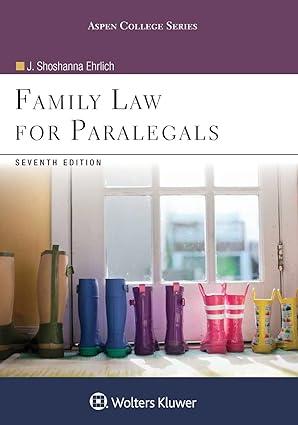.. The mother gave birth to the child (Cheryl) on August 29, 1993. In November, 1993, the...
Question:
.. The mother gave birth to the child (Cheryl) on August 29, 1993. In November, 1993, the [Department of Revenue (department)] filed a complaint in the Probate and Family Court against the father on behalf of the mother and the Department of Public Welfare (now the Department of Transitional Assistance), seeking to establish his paternity. On December 16, 1993, the mother and the father executed an acknowledgment of parentage in which the father acknowledged that he was the father of Cheryl, that he understood his acknowledgment would have the effect of a judgment against him, and that the acknowledgment would obligate him to support Cheryl... The mother, in turn, acknowledged and affirmed that he was the father of Cheryl. That same day, a judge in the Probate and Family Court entered a judgment of paternity. The father, who was not represented by counsel at the time, did not submit to genetic marker testing prior to the entry of the paternity judgment. Nothing in the record explains why. The mother and the father apparently were never married. In the years following the entry of the paternity judgment, the father behaved as though he were Cheryl's father. He and his family visited and bonded with Cheryl. In 1995 and again in 1996, the father, acting pro se, sought successfully to expand and enforce his visitation rights with his daughter. According to the mother, Cheryl, now seven years old, has always called the father "Daddy" and "is bonded to and loves him as her father. In April, 1999, the department filed a complaint seeking to increase the father's child support obligation, and on May 27, 1999, a Probate Court judge ordered the father to pay \(\$ 90\) per week, an increase of \(\$ 33.50\) each week. Five days later, on June 1, 1999, the father filed for the first time a motion requesting an order for genetic marker testing, and an amendment to the 1993 paternity judgment should the test results warrant it. The motion contained a number of unsworn statements, tending to suggest that he believed he was not Cheryl's biological father. More particularly, and of relevance to this appeal, the father's motion suggested that, as early as Cheryl's birth, he may have had reason to suspect that he might not be Cheryl's biological father.....
Questions:
1. What was the nature of the relationship between the "father" and Cheryl?
2. Why did the father seek to set aside the paternity judgment? Why do you think he waited so long to act?
3. What role did genetic marker tests play in this case?
4. What did the trial court say the result should be if the tests showed the father was not Cheryl's biological father?
5. Why did this court decide that the father could not set aside the paternity judgment?
6. Do you think the result would have been different if the father had not delayed as long as he had?
7. What role does biology play in the outcome of this case?
Step by Step Answer:






